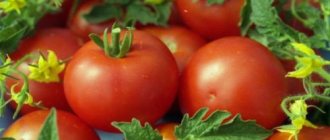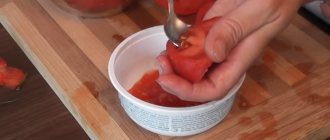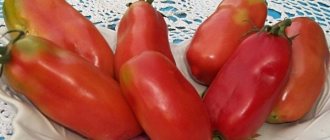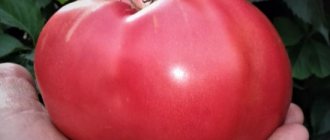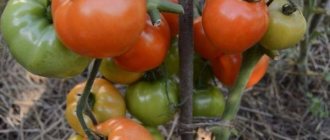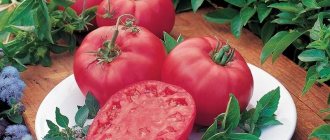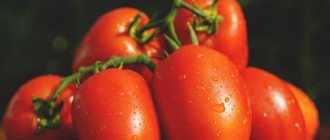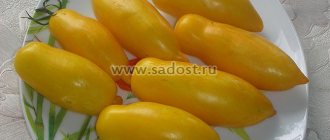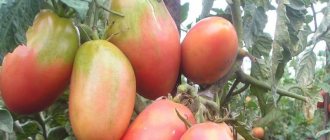Tomato Izyuminka is an excellent early ripening salad variety. Already in July, low bushes are covered with dense clusters consisting of five or six heart-shaped, raspberry-colored tomatoes.
| Height | Landing location | Ripening time | Fruit color | Fruit size | Origin | Fruit shape |
| short | Open ground | Early ripening | Reds | Small | Variety | Heart-shaped |
Features of small-fruited tomato varieties
The advantages of small-fruited tomatoes are not only in appearance, but also in the fact that to grow them it is not at all necessary to take care of a high agricultural background. Such tomatoes are very unpretentious, many do not require chemicals as fertilizers for the growth of stems and fruits, and vegetables also have few seeds. Another big advantage in growing tomatoes that are small in weight is their high yield; in addition, most of these varieties are early, and the harvest in the open ground is obtained already in early June. Fruiting of small-fruited tomatoes continues until the very first frost. The high yield of these mini-vegetables is achieved due to the compactness of the bushes. That is, if an ordinary tomato variety that produces a harvest of large fruits per 1 sq. m we place in the amount of 1, maximum 2 bushes, with a weight of fruits per plant of 5-6 kilograms, then small-fruited ones (both tall and low) do not require much space, and 4-5 bushes, or even more, of such a tomato can easily be placed on the same area, while the total yield in weight does not lag behind large-fruited ones.
Differences between tomato varieties in appearance
- Bush with a thick stem, with corrugated leaves,
- the bush does not need to be shaped,
- the plant does not need staking, removal of stepsons,
- growing side shoots, like the main stem, are capable of producing fruits,
- unpretentious in care and drought-resistant.
Features of planting and caring for tomatoes
All varieties of small-fruited tomatoes are divided into two large groups: tall and short. From this we base what the initial care will be.
For tall varieties of small-fruited tomatoes (Wagner Mirabelle, Garten Freud), it is customary to plant seeds in early spring in separate small containers (pots, cups, boxes); after germination of the seeds and strengthening of the seedlings, the seedlings are transplanted into open ground in beds at a distance of half a meter from each other, maintaining about a meter between rows. After the seedlings have grown, the vegetables must be tied in three levels to a trellis. There is no need for stepsons. If there is a chance of spring frosts, the film can be thrown directly on top of them without fear of breaking them.
The following care and planting are typical for low-growing varieties of small-fruited tomatoes (Florida Petit, Minibel, Tiny Tim): in early spring, we sow the seeds in specially prepared peat soil. As seedlings emerge, we regularly water and loosen the growing seedlings. With the onset of cold weather, we transplant the seedlings into open ground or a greenhouse, no more than 4-5 bushes per square. Low-growing varieties do not need staking and pinching.
Before the onset of cold weather, many tall and low-growing small-fruited tomatoes successfully bear fruit, setting more and more fruits, and with the onset of the first autumn frosts, we tear out the bushes by the roots and hang them on a rope upside down, continuing to receive a harvest
It is important not to just pick the tomatoes and lay them out on a horizontal surface, as vegetable gardeners always do, but to keep the bush with the fruits intact. Small-fruited vegetables have a dense skin and if you pick the fruits from the bush, they will become limp and wrinkled
Brief information about the variety
Tomatoes of the described type have the following qualities:
- tomato produces a good harvest both in greenhouses and in open ground;
- ripening from seedling to fruit continues for 80-84 days;
- the average height of an adult plant reaches 0.45–0.5 m;
- Zest loves heat, so it is recommended to sow tomatoes in the southern territories of Russia on the sunny side, and in the middle zone and Siberia it is necessary to use greenhouses;
- These tomatoes practically cannot tolerate frost, so they quickly die from a sharp temperature change;
- this variety can be stored for a long time and transported over long distances.
The yield of these tomatoes in the open ground of the southern regions reaches 9 kg per 1 m². From the same area in central Russia, the variety’s yield reaches up to 6-7 kg of fruit. In greenhouse farms of the Far North and Siberia, the yield ranges from 5 to 8 kg per specified area.
The yield from 1 bush can reach 4.5-5 kg, but this can only be achieved with the correct agricultural cycle. The average weight of the fruit is 45-50 g. A ripe fruit can be seen in the photo in any agricultural catalogue. The fruits are smooth and pink in color. There are 4 chambers inside the tomato.
Without these conditions, it is impossible to obtain the desired yield due to the fact that the bush may not withstand the weight of the grown fruits and break off while the tomatoes are not yet ripe. Those who planted tomatoes point out another drawback of Izyuminka - this is the unsuitability of this variety of tomatoes for making tomato paste and juice.
Tomato Zest
An early, low-growing, productive variety of tomatoes for open ground and film shelters. The period from germination to the beginning of ripening is about 80 days.
Bush of determinate type, up to 60 cm high. Leaf of ordinary tomato type. The inflorescence is intermediate. The best results were obtained when shaping the plant up to the first flower cluster.
The tomato variety Izyuminka is included in the State Register of the Russian Federation for cultivation in open ground and under film covers on private farms.
Basic qualities of fruits
The fruits are round-heart-shaped, medium density, pink in color at maturity, weighing 80-120 grams, good (for early varieties) taste. Not prone to cracking. These tomatoes are suitable for early fresh salads and home cooking.
This variety is resistant to Fusarium wilt and tobacco mosaic virus.
Features of cultivation, planting and care
We recommend sowing the seeds of this tomato variety for seedlings 55-60 days before planting in the ground. Seedlings dive at the stage of two true leaves. When planting seedlings in the ground for 1 sq. It is recommended to place up to 5 plants per meter of plot.
Further care for tomatoes consists of pinching, fertilizing with complex fertilizers, removing weeds, watering and preventive measures to protect plants and diseases and pests.
If you grew Izyuminka tomatoes, please write whether you liked them or not. What was the yield and taste of the fruits like under your climatic conditions? How would you rate the disease resistance of this tomato? Briefly describe the advantages and disadvantages (pros and cons) of this tomato in your opinion. If possible, attach a photo of your tomatoes to the comment. Thank you!
Your reviews of the tomato Zest and additions to the description will help many gardeners evaluate this variety more objectively and decide whether it is worth planting or not.
Tomato sugar plum raspberry reviews
- 1 Description, characteristics, sowing seedlings, fertilizing, yield, photos, videos and the most common diseases of “Sugar plum” tomatoes
- 2 The sweetest varieties of tomatoes for open ground and greenhouses
- 3 Characteristics of the tomato Sugar plum raspberry and cultivation of the variety
- 4 Cream tomatoes: photos and reviews
- 5 Characteristics and description of the “Sugar plum” tomato: yellow, red, crimson
- 6 Description of the tomato variety Sugar plum raspberry, its care
- 7 Description of the tomato variety yellow and red Sugar plum, its characteristics
- 8 About the sugar plum tomato: description of the tomato variety, characteristics of tomatoes
Tomatoes are very popular among gardeners due to their excellent taste and versatility in use. Among the many varieties of this plant, the group of “Sugar Plum” tomatoes should be especially noted. These varieties are represented by tomatoes of three colors: yellow, red and raspberry. They differ from each other in color and some characteristics.
Tomato Sugar Plum Yellow:
The variety “Yellow Sugar Plum” was bred by Russian breeders. Included in the State Register of the Russian Federation in 2008. Purpose – cultivation in open ground and in greenhouse conditions.
The “Red Sugar Plum” tomato was included in the State Register in 2009. The plant was bred by Altai breeders. Tomatoes grow in fields, gardens and protected ground.
The varietal tomato “Sweet plum raspberry” was bred by Russian breeders. Not included in the State Register of the Russian Federation. The variety is intended for cultivation in greenhouses and under film, but can also grow in open ground.
Tomato Sugar Plum red:
The three varieties of Sugar Plum have some differences.
Red Sugar Plum Tomatoes
The variety has good taste and aroma. The plants are determinate; they require pinching and tying to supports. Tomatoes are mid-early vegetables - the ripening period is 107-110 days.
Main characteristics of the fruit:
- Plum-shaped;
- Sweet taste;
- The tomatoes are the same size;
REFERENCE: The number of tomatoes on a bunch is from 5 to 7 pieces.
- High content of vitamins and nutrients;
- The weight of a ripe tomato is 20-25 grams;
- Chamber tomatoes;
- Resistance to cracking;
- The fruits are excellent for canning and pickling in their entirety.
The review variety is an early-ripening semi-determinate plant. The ripening period for tomatoes is about 87-95 days. The bush grows about 1.2-1.4 m.
Description of the fruit of the variety:
- High commercial quality;
- Yellow tomatoes;
- The pulp is juicy and fleshy;
- The weight of a tomato is 20-25 grams;
- Good keeping quality;
- High keratin content;
- Tomatoes tolerate transportation well;
- Sweet taste;
- Round plum-shaped shape;
- Tomatoes are large, small-chambered - there are 2 nests in one fruit.
Thanks to their unusual color, tomatoes serve as a decoration for fresh salads and various dishes. The review variety is also suitable for canning red tomatoes.
Tomatoes "Sugar plum" raspberry
The bush variety is semi-determinate. The plant grows up to 1.4 m high and requires tying to a support and pinching.
The “Sugar Plum” raspberry variety is an early-ripening tomato, the ripening time of which varies from 87 to 95 days.
Main characteristics of ripe tomatoes:
- Red-crimson fruit color;
- The shape is elongated, plum-shaped;
- The fruit is dense, with fleshy pulp;
- Small-chambered tomato with a small number of seeds;
- Excellent productivity;
- High technological qualities;
- The fruits are stored for a long time;
- Tomatoes tolerate transportation well.
Tomatoes: advantages, disadvantages and taste
The main advantages of “Sugar plum” tomatoes:
- Beautiful fruits;
- Early ripening;
- Excellent taste;
- The fruits can be stored for up to two months;
- Excellent presentation;
- Tomatoes withstand long-term transportation well;
- Tomatoes contain a large amount of useful substances.
The review variety also has some disadvantages:
- The plant is not resistant to diseases and pests;
- Seedlings need to be pinched;
- Each bush needs to be tied to a separate support.
Tomatoes of the subspecies of the “Sugar Plum” variety are intended for fresh use and for preparing salads. They make excellent casseroles, pureed soups and side dishes. Tomatoes are intended for heat treatment. Due to their small shape and beautiful colors, the fruits are often preserved fresh. Less often, tomatoes are pickled.
Growing the Sweet Plum variety requires compliance with certain rules and recommendations.
IMPORTANT: Before planting the seed, it is recommended to moisten the soil.
Before sowing the seeds, you need to sort them out, removing all damaged seeds. Selected planting material should be disinfected in a solution of potassium permanganate. To do this, the seeds are placed in a weak solution of manganese for 10-12 hours. After the specified time, it is recommended to dry the seed thoroughly.
The sweetest varieties of tomatoes for open ground and greenhouses
Sourish, sour-sweet, sweet fruits - these are all different shades of the taste of tomatoes. Depending on his taste preferences, any gardener can find exactly the one that is most pleasant to him.
But many are not limited to one type, but choose varieties of different flavors. Depending on what purpose the tomatoes will be used.
Sweet varieties are popular in slices and plain form, recommended for preparing fresh savory sauces and vitamin juices.
Professor Harry Klee from the University of Florida was able to identify a number of chemical elements that affect the sweetness of tomatoes. In his opinion, the varieties with the predominance of such properties were Chernomor and Master Garden F1. In practice, Russian gardeners have identified the following sweetest varieties of tomatoes for open ground and greenhouses.
Large-fruited sweet varieties of tomatoes
In addition to their pleasant taste, the fruits of this category are distinguished by their size and weight, which makes the process of growing this crop exciting. It's nice to get a vegetable weighing half a kilogram or a little more. Such tomatoes are good when consumed naturally; they look “royal” when sliced or stuffed. Check out the article about indeterminate and determinate tomatoes.
Tomato Sugar Pudovich
Based on the reviews of the Sugar Pudovichok tomato, it deserved the palm among large-fruited varieties. The average weight of its fruits is 500 - 600 g. Bush up to 1.6 m in a greenhouse and up to 0.8 on the street.
With a rich, bright red hue, 4 to 5 fruits per cluster. The yield reaches 11-13 kg per bush. But in addition to large fruits, it conquered Russian summer residents with its taste.
Good for juices and salads, used for canning.
Source: https://dachuvopros.com/tomat-saharnaya-sliva-malinovaya-otzyvy/
Advantages and disadvantages of the Pink raisin variety
Minuses:
- requires a garter to the support;
- afraid of frost.
Tomato growing experts recommend planting this variety in the southern regions. Reviews from amateur and professional summer residents are the most positive. The Izyuminka tomato variety is among the top ten for its pleasant sweetish taste, unpretentiousness, and high yield.
Cocktail tomatoes are not so often found in gardeners' greenhouses, but everyone who has tried to grow Pink raisins is satisfied with the result.
Advantages of the variety:
- very high taste qualities;
- excellent yield (up to 5-6 kg of fruits from one bush);
- unpretentiousness;
- resistance to adverse weather conditions;
- evenness of fruits in the hand;
- excellent keeping quality;
- excellent commercial properties;
- suitability for preservation in whole form;
- early ripening periods (the first “cream” can be skimmed after 90-100 days);
- fruit resistance to cracking;
- good results and abundant fruiting even in a bad season for tomatoes.
A big plus of Pink Raisins is the ability to collect your own seeds. As a rule, such seed material produces healthy and strong plants that bear fruit abundantly.
Tomato Raisin f1 is an early-ripening hybrid and is intended for cultivation in closed ground conditions. The period of fruit ripening from emergence is 90-100 days. The plant is of medium height, the height of the bush reaches 1 m.
4-5 clusters are formed on the main stem. Each of them contains 15-20 pink fruits, shaped like a plum. The crop yield is 2.5-3 kg per 1 m². The value of the hybrid lies in the simultaneous ripening of the fruits.
Tomatoes are distinguished by their high taste, presentation, and ability to be transported over distances. In cooking, the fruits are used for canning and are consumed fresh.
Tomatoes have delicacy and design advantages. They are used whole or cut to decorate dishes, desserts, and cocktails. Cherries complement the taste of hot chicken and fish skewers.
Growing
The tomato variety Izyuminka is recommended to be grown in open ground, hotbeds and greenhouses. Seeds must be disinfected before planting: dilute potassium permanganate granules in boiled water until light pink, place the seeds there for 2 hours. Dry the seed material and plant it in previously prepared soil.
The order of sowing and growing seedlings:
- Mix garden soil with humus and sand.
- It's good to bake in the oven.
- Water and feed in a timely manner.
Seeds for seedlings are planted in late March. When four leaves appear, the tomatoes are transplanted into separate cups. To avoid damage to the root system, seeds should initially be planted in single containers.
See also
Description of the hybrid tomato variety Chibli, its cultivationRead
The seedlings are placed in a warm sunny place. In order for plants to fully grow and develop, it is necessary to unfold the boxes every 2 days. The sun's rays will evenly illuminate the containers from all sides.
Features of outdoor care
After planting seedlings in open ground, the need arises for:
- regular and proper watering;
- complete feeding with fertilizers;
- pinching and formation of the optimal type of bush;
- garter;
- loosening and weeding.
Watering
The interval between the first watering with warm water immediately after planting and the next one is usually a week. "Mikado pink" prefers abundant, but not very frequent watering. Like other tomatoes, this variety does not tolerate stagnation associated with excessive watering.
Therefore, you should start the procedure only after the top layer of soil around the plant has dried slightly. Water must be poured directly under the bush.
However, it is highly not recommended:
- use tap water using a hose, since cold water has a negative effect on the root system of the plant;
- Do not allow water drops to get on the tomato foliage.
Fertilizer application
For the first time after planting seedlings in the ground, they are fed after a couple of weeks. During this period of growing green mass, the plant especially needs nitrogen, which is most widely represented in organic fertilizers.
Find out why and how to properly treat tomatoes with boric acid, Bordeaux mixture, and iodine serum.
Most often they are used in liquid form for watering tomatoes and are prepared from:
- mullein, which is infused in water in a ratio of 1 to 10:
- bird droppings infused in water in a ratio of 1 to 20;
- weeds that are infused with water in arbitrary volumes;
- yeast, in the amount of 10 g added to a bucket of water.
After the first feeding with organic matter, the second is carried out half a month later. This time, the growing ovaries and fruits, which are in need of:
- phosphorus;
- potassium;
- Yode.
The last feeding is carried out when the green fruits reach large sizes.
During this period, tomatoes also require mineral supplements in the form of:
- phosphorus;
- potassium;
- iodine;
- manganese;
- zinc;
- magnesium;
- boron.
Forming and tying bushes
A feature of the indeterminate variety under consideration is the need to install a support pole near the bush simultaneously with planting the seedlings in the ground. A rapidly growing stem is constantly tied to this 3-meter-high support.
Find out how to properly tie tomatoes in open ground and in a greenhouse.
During its growth, starting in July and every 10 days, all stepsons growing from the axils of the leaves are removed. In addition, over time, the top of the main stem is also pinched to limit the upward growth of the bush.
All foliage is also removed from the lower tier and leaves on other tiers are thinned to ensure the best possible exposure of the fruit to sunlight. During the ripening of large fruits, the clusters with them often need additional supports.
Soil care
“Mikado pink” reacts extremely negatively to weeds around its bush, so they should be carefully weeded out, combining this process with loosening the soil. It should be done at least once every half month, but it is best to loosen the soil after each watering.
But care must be taken, since loosening too deeply can damage the root system. Hilling is also useful, as it creates optimal temperature and humidity conditions in the root system.
Often this procedure is replaced by mulching the ground around the tomato bush with humus
Hilling is also useful, as it creates optimal temperature and humidity conditions in the root system. Often this procedure is replaced by mulching the ground around the tomato bush with humus.
How to grow Zest tomatoes?
To grow fruits, this type of tomato is planted using seedlings. In order for the seeds to germinate well, you need to prepare the soil. To do this, use a mixture of earth or turf with humus, mixed with river sand, previously washed in running water.
Before planting in the ground, the seeds must be treated with a solution of potassium permanganate, and it is recommended to calcine the soil in an oven. After the seedlings have germinated, they are hardened off by following the plant feeding regimen and watering them throughout their growth.
Seeds are planted to obtain seedlings in March. It is best to do this in the second ten days of the month, since any cold snap, even short-term, will destroy all seedlings.
The sprouts are transplanted into the ground after 1.5-2 months. It is recommended to make holes in the beds. You need to add mineral fertilizers (for example, superphosphate), plant seedlings, and then water them well with warm water. If there is no superphosphate, then you can use potassium phosphate, eggshells or wood ash.
It is recommended to loosen and mulch the soil in a timely manner. This is done once a decade. Weeding the beds to remove weeds is done once a week. The bushes are fed with mineral fertilizers about 3 or 4 times throughout the season.
Prevention of diseases and protection from garden pests is carried out with the drug Fitosporin and special liquids for killing insects.
After the ovaries appear, the plants are treated with decoctions of natural ingredients or herbal infusions. Such procedures are carried out once every 6-7 days.
To obtain a harvest, it is necessary to form bushes of 1-2 stems. To grow fruits, you need to tie up the bushes in time. Then the berries will grow and ripen almost simultaneously.
Diseases and pests
For late blight, use a solution of copper sulfate (10 g per bucket of water). There are other methods of protection against this disease, as well as varieties resistant to it. “Izyuminka” has strong immunity to fusarium, alternaria, verticillium and tobacco mosaic, but to prevent them, seeds and soil are disinfected.
There are special preparations for pests - insecticides. All spraying is carried out no more than once a week. Most often, tomatoes are threatened by Colorado potato beetles and their larvae, aphids, thrips, spider mites and slugs. On our website you will find a lot of useful information about fighting them:
- How to get rid of aphids and thrips.
- Modern methods of combating the Colorado potato beetle.
- How to effectively resist spider mites.
- Proven ways to get rid of slugs.
Tomato “Zest”: description of the variety and characteristics
| Variety name | Highlight |
| general description | Early ripening, determinate variety of tomatoes |
| Originator | Agrofirm Aelita LLC |
| Ripening period | 80-90 days |
| Form | Heart-shaped |
| Color | Pink |
| Average weight of tomatoes | 80-120 grams |
| Application | Universal. Suitable for baby and diet food |
| Productivity of the variety | up to 5 kg per bush |
| Features of cultivation | Standard agricultural technology |
| Disease resistance | Resistant to major nightshade diseases |
This plant is determinate, bush type - not standard. The stem is thick, heavily leafy, no more than 50 cm high. From this article you can learn everything about indeterminate varieties.
The leaves are medium in size and dark green in color. The structure is wrinkled, without pubescence. The rhizome is powerful, grows wildly, without depressions, its size can exceed 50 cm. The inflorescence is simple, intermediate.
It is laid over 6 - 7 leaves, then goes through 1. There are many fruits in the inflorescence. Pedicel with articulation. Tomato “Izyuminka” is an early ripening plant; fruit ripening occurs on the 80th day after germination. Resistant to fusarium and tobacco mosaic.
Growing is possible in open ground, in greenhouses, greenhouses and under film.
The shape is round with an elongation at the end (heart-shaped). The sizes are medium-sized, weight 80-120 g. The skin is smooth and dense. Ripe fruits are pink in color, while unripe ones are the usual pale green. There are a lot of seeds, distributed in 3-4 chambers. The amount of dry matter is increased. Picked fruits are stored for a long time, transportation takes place without consequences. Tomato harvest should be stored in a dry and dark place.
The table below provides comparison data on fruit weight for other tomato varieties:
| Variety name | Fruit weight |
| Highlight | 80-120 grams |
| Fat Jack | 240-320 grams |
| Premier | 120-180 grams |
| Broody | 90-150 grams |
| Polbig | 100-130 grams |
| Brawler | 100-180 grams |
| Black bunch | 50-70 grams |
| Grapefruit | 600-1000 grams |
| Kostroma | 85-145 grams |
| American ribbed | 300-600 grams |
| The president | 250-300 grams |
Russian breeders participated in the development of the variety; the originator is Agrofirm Aelita LLC. Included in the State Register of the Russian Federation for cultivation in open and closed soils in 2008. They are grown in all regions of the country and nearby areas. In the northern regions, growing indoors or with temporary shelter is preferable.
According to the method of use, it is universal. Delicious sweetish fruits are suitable for salads, sandwiches, hot dishes, and sauces. Due to the high content of dry substances, they do not crack when canned whole. For the same reason, they are not suitable for juice production. Despite the small size of the fruit, the harvest is excellent, about 9 kg per 1 sq.m. Up to 5 kg from 1 plant.
You can see the yield of other varieties in the table:
| Variety name | Productivity |
| Highlight | up to 5 kg per bush |
| Olya-la | 20-22 kg per square meter |
| Nastenka | 10-12 kg per square meter |
| King of Kings | 5 kg per bush |
| Banana red | 3 kg per bush |
| Gulliver | 7 kg per bush |
| Brown sugar | 6-7 kg per square meter |
| Lady Shady | 7.5 kg per square meter |
| Rocket | 6.5 kg per square meter |
| Pink Lady | 25 kg per square meter |
Subtleties of agricultural technology for early ripening varieties. Which tomatoes have high yields and have excellent immunity?
>Photo
a brief description of
- Where to grow: protected and unprotected soil
- Bush height, cm: up to 50
- Ripening time, days: 80–85
- Productivity, kg per 1 m2: 9
- Fruit weight, g: 50
- Application: salads, vegetable dishes, whole fruit canning
- Advantages: short ripening time
- good product characteristics
- transportability
- high yield
- good immunity to diseases
- not suitable for making juices and tomato pastes
Agricultural technology of Pink raisins
Seedlings are planted in the ground when the soil warms up.
For early-ripening tomatoes, it is especially important to adhere to the timing of picking. If you keep seedlings in pots, it will be more difficult for them to adapt after picking
The time for planting the Pink Raisin tomato depends on the climatic conditions of the region. The further north the city is, the later the seedlings are planted in open ground.
Planting tomatoes in a permanent place
When choosing a site for growing tomatoes, it is important to consider several nuances:
Tomatoes are light-loving plants. For them, choose a plot of the garden that is in the open sun. Tomatoes should not be planted in beds where nightshade crops have grown for the past 3 years.
The best precursors for tomatoes are legumes, melons, onions, and cucumbers. It is important to choose the right neighbors for tomatoes. Potatoes should not be planted near tomato beds.
If tomatoes are grown in a greenhouse, no other plants are planted in the same room.
It is important to properly prepare tomato beds. They are dug up and cleared of plant debris and roots.
To enrich the soil, add cow manure, chicken manure or humus. To reduce the acidity of the soil, add ash or dry lime.
Holes 25-30 cm deep are dug in staggered rows. For 1 sq. m place no more than 3 plants. A handful of ash and long-acting granular complex fertilizers are poured into each cavity.
2-3 days before planting in the ground, the tomatoes are watered and fed. Directly during picking, the plants are removed from the pots and placed in the holes, slightly deepening the stem.
The soil around the tomatoes is compacted. Tomatoes are watered using 1 liter of warm water for each plant.
Further care
Pink raisin bushes need to be tied up. To do this, use strong supports with a height of at least 1.5 m. The garter thread must be made of synthetic fibers. It will not rot or damage the stems of the plant.
Tomatoes are formed into 2-3 stems. The more stems left, the more abundant the harvest will be, but the later the fruits will ripen.
During the pinching process, the lower leaves up to the first cluster are also removed. This procedure is carried out once a week. It is also necessary to get rid of withered and yellowed greenery.
Tomatoes are watered 2-3 times a week. For 1 plant use 2-2.5 liters of water. This procedure is carried out early in the morning or at sunset.
After each watering, the soil is loosened. The beds are weeded weekly.
Fertilizing is applied 3-4 times per season. Alternate mineral and organic fertilizers. If long-acting granules are first poured into the holes, the number of feedings is reduced to 2.
Foliar fertilizing is applied 1-2 times. Use products containing boron.
Nuances of cultivation
When cultivating Pink Raisin tomatoes, it is important to consider several nuances of growing this hybrid:
- Pink raisin clusters are heavy due to the large number of fruits. If they lean towards the ground, use additional support.
- This tomato takes up a lot of space. Gardeners advise setting aside a separate corner in the greenhouse for the bush.
- If the bushes produce a lot of greenery and few fruits, it means that the tomato is faced with an overabundance of fertilizers.
- Incorrectly formed inflorescences are removed.
- To help fruit set, Pink Raisin bushes are shaken regularly.
Diseases and pests
Hybrid Pink raisins are resistant to most tomato diseases. But this does not mean that if the rules of prevention are not followed, an infection will not strike him.
It is important to avoid infection on tomatoes. Fungal and viral pathogens multiply in the soil, on seedling pots and garden tools
Disinfection will help get rid of them.
To prevent plants from being damaged by insects (whiteflies, aphids, mites), plants are sprayed with purchased products (Confidor, Actellik, Fufanon) and home remedies.
Growing tomatoes
“Zest” is intended for growing through seedlings with subsequent planting in a garden or greenhouse.
How to prepare seeds?
To improve germination and strengthen immunity, complete pre-sowing seed treatment should be carried out.:
- Rejection. The seeds are poured with saline solution for 5 minutes and mixed well. Seeds that are on the surface of the water should not be planted - they are empty;
- Disinfection. The seed material is pickled in a solution of potassium permanganate (10 mg per 50 ml of water) for an hour. This treatment destroys surface fungi and bacteria that could cause diseases at an early stage of growth;
- Stimulation. Solutions of the preparations “Zircon” or “Epin-Extra” increase the germination of plants from a nominal 60 to the desired 90%;
- Soak. On the eve of planting, the seeds are placed in melt water for 12 hours. To do this, remove a previously prepared piece of ice from the freezer. The first thawed water is drained, and the next one is used for soaking, bringing it to room temperature. To enhance the effect, it is advisable to install a compressor that continuously pumps air into the container with seeds and water.
Sowing seed material
REFERENCE : Due to the rapidly developing root system, seedlings overexposed in a pot may produce a weak harvest or not form ovaries at all. Therefore, sowing time must be calculated accurately. This is done by subtracting 35 days from the last spring frost date.
Seeds are sown in the 1st-2nd decade of April - 35-40 days before transplanting to a permanent place. Wooden boxes, cut-off tetrapacks, and pastry molds are used as planting containers. The main thing is that the depth of the container is more than 7 cm, and that drainage holes are made in the bottom.
Expanded clay or charcoal is poured into a 2 cm layer at the bottom of the pot, then 5 cm of base soil is poured - a mixture of garden soil, peat and sand in proportions 2:2:1. The seeds are deepened by 1.5 cm, leveled and watered generously with warm water. 3-5 days after the emergence of seedlings, the seedlings are brought out into the light. The recommended temperature for growing is 22-24*C.
IMPORTANT : Most infections reach the seeds during planting. Therefore, planting activities should be carried out using disposable gloves, garden tools and containers should be disinfected with a chlorine solution, and the soil should be steamed to 60*C before filling.
Rules for planting seedlings
When the growth reaches 25-30 cm, the seedlings are transplanted for permanent residence. Two weeks before planting, the plants begin to harden, taking them out into the open air at a temperature of +15*C. Every day, the time spent in cool conditions is increased by 1-2 hours, gradually increasing to around the clock.
Recommended planting pattern:
- The interval between bushes is 50 cm;
- Row spacing – 60 cm;
- Planting hole depth – 15 cm;
- The maximum planting density is 5 bushes per 1 sq.m.
At the time of planting seedlings, the soil should be warmed up to 10*C, and the average daily air temperature should not fall below 12*C. The plants are replanted with a large lump of earth, or, if the picking was done in paper glasses or peat pots, together with the container. This helps protect the roots from damage.
Tall tomatoes growing and shaping. Overview of varieties:
Bush care
“Izyuminka” is a high-yielding variety. Despite its short stature, it requires proper formation and timely garter. Otherwise, a large amount of non-commercial small items will grow or the branches will break off under the weight of the fruit.
Basic rules for caring for bushes:
- Constant pinching, starting from the second week after planting. The bush is formed into 1-2 stems, cutting off unnecessary stepsons when they reach a length of 5 cm;
- Attaching to trellises, posts, greenhouse frames, as well as installing supports for large fruit clusters;
- Shallow watering every 3-5 days depending on the weather. Watering should be balanced: the ground should be moistened by 25-30 cm, but water should not stand on the beds;
- Loosening the soil and weeding between waterings. The main task of the gardener is to prevent the formation of a hard earthen crust;
- Mulching the beds with straw to retain moisture in the soil;
- Weekly feeding with diluted manure, superphosphate or NPK complexes.
Miracle bunch
Photo by Alexey Kuraev
Photo by Zinaida Lazareva
Photo by Valentina Matveeva
The last place in our ranking of the best cherry tomatoes of 2019 is occupied by the Miracle Bunch hybrid. The tomato is intended for both open and closed ground. In a greenhouse it grows up to 2 m in height, in open beds - about a meter. It is recommended to form a bush with 1-2 stems and plant no more than 3 plants per 1 sq.m.
The red fruits have juicy and sweet pulp. They are suitable for both canning and fresh consumption.
The hybrid is quite productive. One bunch can grow up to 40 tomatoes. With proper care, you can harvest 2.5 kg of tomatoes from the bush.
Description
The variety was created specifically for Russian gardeners. Therefore, it is suitable even for risky farming areas. In the south, tomatoes grow well outdoors in sunny areas. In the north, “Izyuminka” can only be planted in a greenhouse. This is a heat-loving crop. It does not tolerate frosts and sudden temperature changes.
This is a determinate plant. Therefore, the harvest ripens quickly and smoothly. The bush stops growing after the formation of several clusters of tomatoes. And he directs his efforts to their development. From one bush you can collect up to 5 kg of tasty and sweet fruits.
To produce a good harvest, it is recommended to grow the variety in seedlings. Preferably in protected ground. Tomatoes need pinching, forming a trunk into 1–2 stems, and tying them to a vertical support.
Planting
When planting, it is necessary to adhere to hygiene rules, since the description of the Swat f1 tomato indicates that infection can reach the seeds through insufficiently carefully treated containers. It is also preferable to perform all work with gloves or wash your hands periodically.
Seeds for seedlings are planted between March 15–20 and March 30. No more than 60 days should pass before planting and before planting in the ground. Charcoal drainage and well-mixed seedling soil are poured into the container. Then the soil is moistened and holes 1 cm deep are made in it, at a distance of 3 cm from each other.
After the seeds are planted, they are covered with dry soil on top and removed to a warm place. The room temperature should be 28–30 °C.
Maintaining the temperature regime is extremely important, otherwise the seeds will rot or take a long time to germinate. When the first shoots appear, the temperature drops to 15–18 °C during the day and 10–12 °C at night. After a week, the temperature rises again to 20–25 °C during the day, and 12–15 °C at night
After a week, the temperature rises again to 20–25 °C during the day, and 12–15 °C at night
When the first shoots appear, the temperature drops to 15–18 °C during the day and 10–12 °C at night. After a week, the temperature rises again to 20–25 °C during the day, and 12–15 °C at night.
Landing
Before planting in a permanent place, tomatoes should be thoroughly watered with warm water. When transplanting outdoors, make sure that the threat of frost has passed. Seedlings are planted under the film in mid-May.
Before planting plants in open ground, you need to select a suitable site. Those who have previously planted tomatoes know that tomatoes will not grow in the area where potatoes were grown. This crop does not tolerate acidic soil. Before planting, apply fertilizer and water the soil with warm water.
In order for the yield to be high, the plants should be weeded in time, getting rid of weeds, watered and fed in a timely manner.
When a full-fledged bush grows, you need to trim off the excess stepsons before flowering. This procedure must be repeated a second time after fruit set.
High yields can be achieved without fertilizing:
- Plant in well-warmed soil.
- Water in a timely manner.
- Clear the area of weeds.
In order for the roots of the seedlings to firmly take root in a new place, at first you need to water the bed every day. After each watering, the soil must be loosened to allow access to oxygen. The roots should not be buried too deeply. Plant no more than 8 bushes per 1 square meter.
Various varieties of low-growing small-fruited tomatoes
This is a variety of tomatoes whose average plant height is usually from 20 to 25 centimeters and does not exceed 40.
Florida Petite
The most popular low-growing, small-fruited variety, famous for its compactness, decorativeness and unique taste. The variety is intended to be considered early, since when vegetable seeds are planted early (at the end of February), the first harvest is obtained already in mid-May. Many summer residents plant small bushes, up to 20-25 centimeters high, as a compactor for newly transplanted strawberries, thereby making good use of the free space (15 seedlings or more are placed on 1 square of area). From one bush of this high-yielding variety, about 500 fruits weighing 25-35 grams are usually harvested. Tomatoes do not require special care; loose, fertile soil and regular moderate watering with heated well water (this is the best option) will ensure the appearance of strong, juicy fruits.
Minibel
The second most popular variety of low-growing, small-fruited tomatoes, producing medium-sized fruits weighing no more than 30 grams. For 1 sq. m, 10-15 plants will confidently grow, each of which gives the summer resident about one kilogram of medium-sized vegetables per season. The side shoots, as soon as the main stem grows, gets stronger and acquires color and the first fruits, begins to grow and bloom. Thanks to the side shoots that bear fruit until frost, the variety is considered to be mid-season; the first tomatoes begin to turn red around mid-to-late June. The rules of care are standard: moderate watering, fertilizing, loosening.
Tiny Tim
At the level of other low-growing plants, this small-fruited variety of vegetables is considered the tallest, since its seedlings reach a height of up to 40 centimeters. This is not only a tall variety, but also abundantly fruiting; from one bush, a summer resident collects 2 kilograms of red tomatoes or more. The fruit, however, weighs very little - max. 15 gr. The variety is less compact than the first two and more whimsical: no more than 6 bushes can be planted on 1 square; the variety requires preliminary planting and long-term holding of the seedlings on a warm windowsill. The variety is resistant to diseases and light frosts.
Description and characteristics of the variety
Manych F1 belongs to the collection of classic early-ripening red tomatoes. The hybrid is determinate, grows in compact, easy-to-care-for bushes. It bears fruit evenly throughout the season - from June to mid-September.
- determinant growth;
- medium-sized strong shoots;
- length - 80 cm;
- there are 4–6 fruits on one hand;
- moderate foliage and shoot formation.
Neat tomatoes are used in home kitchens, for sale and for industrial preparation. Description of fruits:
- average weight - 180–200 g;
- shape - round;
- coloring - bright red;
- the skin is glossy, does not crack, durable;
- the pulp is sugary, compacted, moderately juicy;
- The taste combines sourness and sweetness.
Tomatoes are cut into salads and snacks, small tomatoes are canned, larger ones are processed into juices and sauces.
Characteristics and description of the tomato variety Izyuminka
- early ripening - after seedlings sprout, full ripening of the fruit occurs on the 75th - 80th day;
- low bush - 55 - 60 cm;
- leaves are dark green, medium size;
- a thick stem with a powerful rhizome that grows wildly in width;
- intermediate type of inflorescence;
- the stalk has an articulation;
- the fruit is slightly elongated;
- pink-red color;
- There are 5 – 6 fruits in one inflorescence.
Thanks to their dense and elastic skin, tomatoes will not burst when pickling and salting. The fruits contain little water and are ideal for pickling and making salads. Despite the small size of the tomatoes, the yield is high: from 4 to 5 kilograms per bush.
Use
Universal to use. Tomatoes have a sweetish taste. With a minimal amount of liquid, this tomato variety is not suitable for making juice.
The fruits are great for sandwiches and added to hot dishes. Used in preparing salads and sauces.
Varieties of tomatoes
Cherry tomatoes, as seen in the photo, are distinguished by small fruits, similar to cherries, slightly elongated in shape. Cherry tomato contains a large amount of dry nutrients and sugars dissolved in intercellular juice.
Selection work has led to the appearance of fruits with different flavors and colors. The hybrid is distinguished by its decorative appearance during flowering and during the ripening period.
Tomato Raisin During the growing season, a bush 1 m high is formed on the main stem; 4-5 clusters with pink fruits weighing 20-30 g are formed.
The Pink Raisin tomato is a mid-early variety with unlimited growth. The leaf is medium in size, light green in color, and has a wrinkled structure. A complex inflorescence is formed at the level of 6-8 leaves and is then laid at intervals of 1 leaf.
A high yield is achieved when the plant is formed into 2-3 stems. The tomatoes are elongated, resemble a plum in appearance, and at the ripe stage, as can be seen in the photo, are rich pink in color with a pearlescent tint.
Description of fruits:
- Up to 50 fruits ripen on 1 cluster, about 5 cm in size.
- The weight of a tomato reaches 50-150 g.
- When cut horizontally, 2-3 chambers with seeds are visible.
- The skin is smooth, thin, the flesh is fleshy, dense, sweet in taste.
- Ripe tomatoes can hang on the trusses for a long time without losing their appearance.
We suggest you read: How garlic is used against worms
The tomato has a high degree of resistance to diseases and is intended for cultivation in open ground and greenhouses.
An excellent early variety for snacks is the Zest tomato: description of tomatoes and characteristics
Tomato Izyuminka is an excellent early ripening salad variety. Already in July, low bushes are covered with dense clusters consisting of five or six heart-shaped, raspberry-colored tomatoes.
| Height | Landing location | Ripening time | Fruit color | Fruit size | Origin | Fruit shape |
| short | Open ground | Early ripening | Reds | Small | Variety | Heart-shaped |
Description and characteristics of the variety
The variety is early ripening and begins to bear fruit on the 105th day after germination. The plants are determinate, 55-60 cm high. Despite their short stature, it is better to pin the bushes and tie them up, since due to the abundance of brushes and leaves they lie down.
The shape of the fruit is heart-shaped, the tomatoes are smooth and dense, green when unripe, pink when ripe. There are 3-4 nests inside with a small amount of seeds. Average weight 50 g.
Country of origin, year of registration
The Izyuminka tomato was bred in Russia. The variety was registered in 2008, agro originator, Moscow.
Growing regions
The variety can be grown in any region, in open ground and in a greenhouse. It is suitable for canning whole fruits, pickling and preparing summer vegetable salads.
Advantages and disadvantages
- almost never gets sick;
- high productivity;
- bears fruit throughout the summer;
- great taste.
Possible problems:
- does not tolerate frost;
- needs a garter.
Features of cultivation and storage
The peculiarity of the cultivar is its friendly shoots. Seeds, even after long-term storage, have high germination energy and do not require pre-sowing treatment. They can simply be disinfected in potassium permanganate for 20 minutes and then washed in clean water.
Izyumina fruits are not suitable for long-term storage. When ripe, they will last no more than 5-7 days in the refrigerator.
Planting and care
In mid-May, the seedlings are transferred under film, and in early June - into open ground. Seedlings should have 5-7 true leaves and the first brush before planting. Plants are planted according to a 50 by 40 cm pattern. Fruit harvesting begins in July and continues until the beginning of September.
Varietal characteristics
In order to decide on the place to plant Izyuminka tomatoes, you need to familiarize yourself with the characteristics and description of this variety.
Characteristics of the variety Izyuminka
- Cold resistance – average. This variety does not tolerate sharp temperature fluctuations and drops, so in regions with cold climates it is grown indoors: in greenhouses or greenhouses.
- Bush growth vigor . Depending on the planting location, the height of the plant can reach from 50 cm (for open ground) to 60 cm (in a greenhouse). Spreading bushes with medium-sized dark leaf blades have a powerful root system.
- Disease resistance . Zest is practically not affected by tobacco mosaic and fusarium.
- Ripening dates are early. Already 80 days after the sprouts appear, the fruits are fully ripened.
- Flowering is amicable, and therefore the yield is quick. When planting bushes in protected ground, they are periodically shaken during flowering for pollination.
- The fruits are elongated, heart-shaped, red-pink in color. The weight of one fruit is no more than 50 g. The taste is sweet, dessert.
- Productivity . The variety is considered productive - up to 5 kg of medium-sized tomatoes can be harvested from one plant per season.
Important! Many people confuse the Raisin tomato with the Raisin. Although their names are very similar, the characteristics of these species differ: Raisin tomatoes are tall plants with small cherry tomatoes.
"Mikado golden"
A variation of the golden mikado was published under the auspices of. Who the breeder and author of the variety remains unknown. Tomatoes are yellow in color, why they were called golden still remains a mystery.
Characteristics and description
Tomato “Mikado golden” reviews, photos, who planted it, indicate that this is a medium-ripening variety and tall.
The fruits of this variety are round or slightly flat-rounded, and the same plant can bear fruits of different shapes. The size of a tomato is on average 300-400 g, some specimens reach up to 500 g.
Golden Mikado tomatoes are fleshy, have many (6-8) seed chambers filled not with the liquid fraction, but with the “body”, but the number of seeds is completely small.
The tomatoes taste very pleasant, balanced, with a good proportion of sugars, but at the same time with a noticeable tomato taste and aftertaste. The increased content of beta carotene puts this variety in the category of a dietary product. Such fruits are recommended for baby food, and can also be consumed by people suffering from gastrointestinal disorders.
The fruits are very good fresh, and the surplus harvest can be used for processing for the production of purees, juices, pastes and ketchups.
Resistance to diseases and pests
Tomatoes require preventive treatments against dangerous fungal diseases.
There is no point in risking the whole plant and, having grown it, losing it. Modern drugs:
- available;
- effective;
- complex.
By treating the plant in a timely manner, there is no need to be afraid, and the harvest can be harvested large and healthy.
Advantages and disadvantages
This tomato variety has true advantages:
- large fruit;
- excellent taste;
- tolerates temperature changes well.
As a disadvantage, it can be noted that sometimes tomatoes crack.
Features of growing the variety
Each tall tomato requires shaping and tying. A special feature of the golden mikado is that its fruits are huge. Without human help, the plant will not be able to form huge fruits, much less keep them on the shoots.
To get super fruits you need to take stepson. To do this, as soon as the stepson reaches 4-5cm, it must be removed. A special feature of the variety is that stepsons are not formed constantly. After 2-3 pinchings, the plant remains formed.
